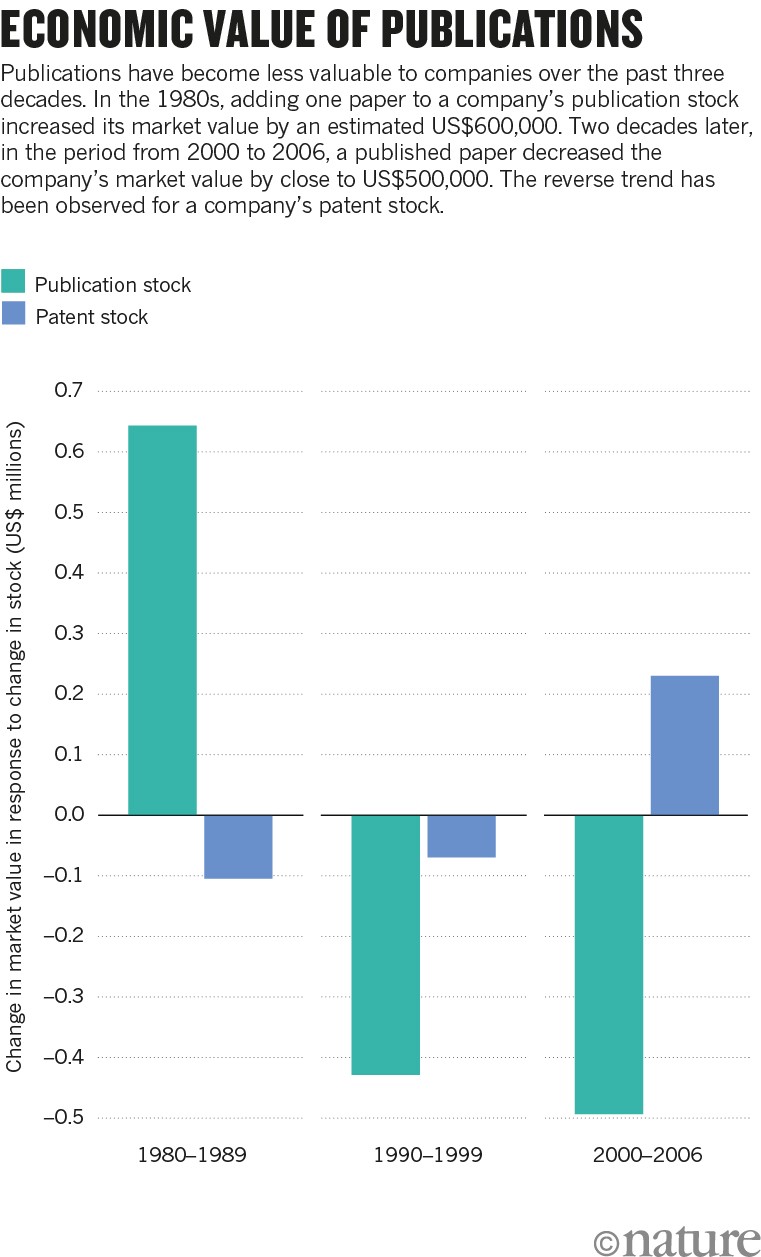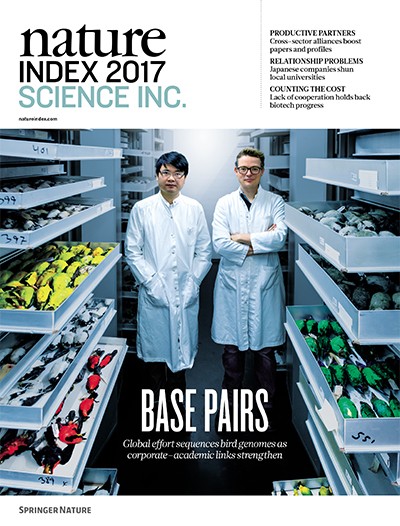The United States is witnessing a growing division of labour between universities and corporations. As industry conducts less research and more development, academia is picking up the slack in scientific discovery. The trend represents the loss of an important source of innovation — corporate science.
Corporations in the US are spending a diminishing portion of their R&D budgets on research. The share of basic and applied research in corporate R&D has tapered from 28% in 1985 to 20% in 2015.
Corporate representation in the scientific literature is also shrinking. In an analysis of publications authored by publicly traded US companies in the Web of Science database, we observed that the annual average number of papers published per company fell from around 25 in 1980 to less than 10 in 2010. The drop was visible across a wide range of industries and most pronounced among firms with established research programmes, for which the number of publications fell by as much as 65% between 1980 and 2006.

Source: Arora, A., Belenzon, S. & Patacconi, A. NBER (2015)
It isn’t that research is becoming less relevant for innovation. It’s that companies are just not as willing to invest in the long slog of science. While patents continue to cite the science and engineering literature at ever-increasing rates, patents authored by at least one corporation cite less of their own published work, and more papers published by external institutions. Instead of building on internal research, corporations are relying on universities, national labs and other public research institutes.
These trends are reflected in the private sector’s declining valuation of research. Based on our estimates, the stock market value associated with one publication by a firm with an established research programme fell from US$900,000 in 1980–1990 to US$295,000 in 1990–2000 — a drop of 67%. Our calculations indicate that, between 1980 and 2006, the market value attributable to the stock of scientific knowledge among an established firm’s intangible assets declined by between 28 and 32% (see graphic for data on all firms).
Part of Nature Index: Science Inc.
The decline in corporate research has indeed coincided with the increased importance of university research. In 2013, universities in the US accounted for 51% of basic research and 14% of total research spending. Universities also produced nearly 75% of the total scholarly output in 2013, up from 69% in 1999.
Prompted in part by the Bayh–Dole Act, which permits academic institutions to own patents resulting from publicly funded science, American universities have become more engaged in the commercialization of their research, filing for patents at an increasing rate, from 2,266 in 1996 to 5,990 in 2014. The number of university-spawned start-ups has nearly doubled, from around 400 in 2001 to nearly 760 in 2013.
The relationship between university and corporate research is complex. Where university research can substitute for corporate research, companies can rely on universities, and the start-ups that they generate, to produce the science and technology that they need to grow. But there are cases where the decline of research produced by large firms could pose problems for society. We highlight two key concerns.
First, the type of research conducted in large firms is difficult to replicate in universities and small firms. Compared to their smaller counterparts, large firms have access to greater financial resources and can tackle multidisciplinary problems by integrating multiple knowledge streams and capabilities. They can also organize research by problem, rather than by discipline, the approach taken by universities. Germany’s slow entry to the biotechnology sector, for example, has been attributed to the rigidity of the country’s university departments.
Second, coordination between R&D and manufacturing is an important source of innovation. Daniel Holbrook at Marshall University and his collaborators found that such cross-talk contributed to the early commercial success of the semiconductor company, Fairchild, which was recently acquired by ON Semiconductor, and the firm’s two major discoveries: the planar process and integrated circuits.
The departure of great corporations from the annals of scientific discovery could also lead to the retreat of spinoffs that contribute greatly to economic growth and social welfare. Analysis by Steven Klepper, the late economist from Carnegie Mellon University, found that in many high-tech industries, including early automobile, semiconductors and lasers, the leading firms produced more and better spinoffs. For instance, between 1895 and 1966, spinoffs accounted for 20% of all the entrants in the automobile industry (145 of 725), but 67% (14 of 21) of the later industry leaders.
A new innovation ecosystem, where most research is performed by universities and start-ups may be more efficient and nimbler, but reasons for concern remain.

 Outsourcing discovery
Outsourcing discovery
 A firm shift
A firm shift
 Industry links boost research output
Industry links boost research output
 Help wanted: industry seeks science allies
Help wanted: industry seeks science allies
 Lost opportunities
Lost opportunities
 In good company
In good company
 First among equals
First among equals
 Corporates make reluctant partners
Corporates make reluctant partners
 A guide to the Nature Index
A guide to the Nature Index





